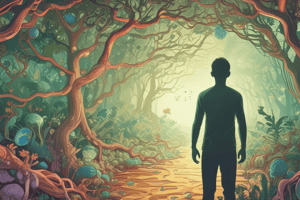Podcast
Questions and Answers
Which of the following microorganisms is NOT a cellular microorganism?
Which of the following microorganisms is NOT a cellular microorganism?
- Viruses (correct)
- Bacteria
- Protozoa
- Fungi
What is the term used to describe microscopic organisms that are collectively referred to as microorganisms or microbes?
What is the term used to describe microscopic organisms that are collectively referred to as microorganisms or microbes?
- Viruses
- Microbes (correct)
- Agents
- Germs
What is the term used to describe multicellular animals that are visible to the naked eye and cause human infections?
What is the term used to describe multicellular animals that are visible to the naked eye and cause human infections?
- Microorganisms
- Fungi
- Helminths (correct)
- Protozoa
Which of the following microorganisms is NOT a type of cellular microorganism that causes human disease?
Which of the following microorganisms is NOT a type of cellular microorganism that causes human disease?
What makes microorganisms both easy and difficult to study?
What makes microorganisms both easy and difficult to study?
What is used to analyze microorganisms in addition to using microscopes?
What is used to analyze microorganisms in addition to using microscopes?
What is the term used to describe microorganisms that are single-celled?
What is the term used to describe microorganisms that are single-celled?
What is the main focus of this book?
What is the main focus of this book?
What is a common misconception about microorganisms?
What is a common misconception about microorganisms?
What is unique about helminths?
What is unique about helminths?
What is the purpose of Table 1.1?
What is the purpose of Table 1.1?
Why are microorganisms difficult to study?
Why are microorganisms difficult to study?
What is a characteristic of archaea?
What is a characteristic of archaea?
What is true about microorganisms that cause human disease?
What is true about microorganisms that cause human disease?
What is the focus of this book?
What is the focus of this book?
Why are microorganisms easy to study?
Why are microorganisms easy to study?
Flashcards are hidden until you start studying
Study Notes
Microbiology: Definition and Scope
- Microbiology is a specialized area of biology that deals with living things too small to be seen without magnification.
- Microorganisms, or microbes, are collectively referred to as living things that are too small to be seen without magnification.
Types of Microorganisms
- Microorganisms can be either cellular or noncellular.
- Cellular microorganisms include bacteria, archaea, fungi, and protozoa.
- Acellular microorganisms include viruses and prions.
- Helminths are multicellular animals whose mature form is visible to the naked eye, but are not technically microorganisms.
Characteristics of Microorganisms
- Microorganisms reproduce rapidly, making it easy to grow large populations in the laboratory.
- However, they are difficult to study because they are usually invisible to the naked eye.
- Microbiologists use indirect means of analyzing microorganisms, in addition to using microscopes.
Scope of Microbiology
- Microbiologists study every aspect of microorganisms, including their cell structure and function, growth and physiology, genetics, taxonomy, and evolutionary history.
- They also study microorganisms' interactions with the living and nonliving environment, including their uses in industry and agriculture, and their interactions with mammalian hosts.
Importance of Microbiology
- Studies in microbiology have led to a greater understanding of many general biological principles.
- The study of microorganisms has established universal concepts concerning the chemistry of life, systems of inheritance, and the global cycles of nutrients, minerals, and gases.
- Microbiology has also led to the development of various branches of study, including virology, mycology, and parasitology.
Microbiology: Definition and Scope
- Microbiology is a specialized area of biology that deals with living things too small to be seen without magnification.
- Microorganisms, or microbes, are collectively referred to as living things that are too small to be seen without magnification.
Types of Microorganisms
- Microorganisms can be either cellular or noncellular.
- Cellular microorganisms include bacteria, archaea, fungi, and protozoa.
- Acellular microorganisms include viruses and prions.
- Helminths are multicellular animals whose mature form is visible to the naked eye, but are not technically microorganisms.
Characteristics of Microorganisms
- Microorganisms reproduce rapidly, making it easy to grow large populations in the laboratory.
- However, they are difficult to study because they are usually invisible to the naked eye.
- Microbiologists use indirect means of analyzing microorganisms, in addition to using microscopes.
Scope of Microbiology
- Microbiologists study every aspect of microorganisms, including their cell structure and function, growth and physiology, genetics, taxonomy, and evolutionary history.
- They also study microorganisms' interactions with the living and nonliving environment, including their uses in industry and agriculture, and their interactions with mammalian hosts.
Importance of Microbiology
- Studies in microbiology have led to a greater understanding of many general biological principles.
- The study of microorganisms has established universal concepts concerning the chemistry of life, systems of inheritance, and the global cycles of nutrients, minerals, and gases.
- Microbiology has also led to the development of various branches of study, including virology, mycology, and parasitology.
Studying That Suits You
Use AI to generate personalized quizzes and flashcards to suit your learning preferences.




